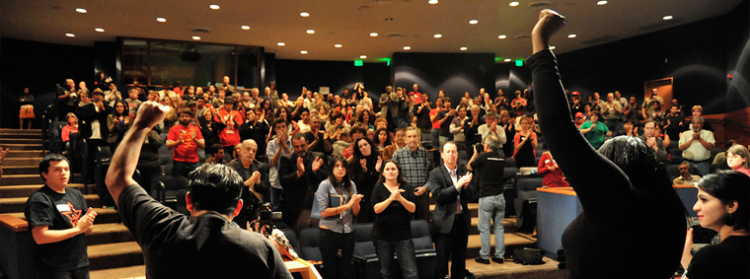How to deliver an impressive presentation (IMPRESSentation) Part 2
A couple of days ago, we talked about the first part of this article on how to deliver an IMPRESSentation but before we move on with remaining five (5) ‘Goods of IMPRESSentation’ to complete our eleven (11) keys to winning hearts and minds with words, let’s first go through a quick review of the first six (6).
1. SUBJECT MASTERY
- Research about our topic.
- Collect and organize data to support our points.
- Organize and present our thoughts in an outline.
- Know our stuff by heart.
2. QUALITY POWERPOINT PRESENTATION
- Show consistency. Standardize our slide elements’ position, size and color.
- A dark background requires a light text color.
- Limit our text lines to seven (7) for bulleted enumerations.
- Avoid fancy fonts.
- Never capitalize all of our letters.
- Don’t overwhelm our slides with graphics.
- Choose our design templates carefully.
- Simplify our transitions and animations.
- Use high-resolution and concepts-representing images.
- Don’t read from or speak to our slides.
3. SUFFICIENT PREPARATION
- Rehearse.
- Profile our audience beforehand.
- Manage our nervousness before, during, and even after our presentation.
- Prepare for the unexpected and just play everything by ear.
- Do our pre-work.
- Just be ‘IN THE ZONE’.
4. PRESENTER’S PACKAGING
- Be mindful of our aura and demeanor in front.
- Think through what we ought to wear and how to wear them.
5. VOICE QUALITY
- Sound clear and fluid.
- Emphasize words correctly with the right intonation.
- Be careful with your highs and lows.
- Match your explanations with the right emotions.
- Don’t talk too fast nor too slow.
- Modulate your voice appropriately.
6. THOUGHT ORGANIZATION
- Send our message across accurately.
- Stick to our outline or timetable and don’t get lost.
- Use transitioning to connect our slides to one another.
I hope that by this time, you’ve already been applying the first six (6) winning keys or Goods of IMPRESSentation. At this point, let’s now talk about the Goods # seven (7) to eleven (11).
7. DELIVERY
The success of our presentation heavily relies on how we send across the message we need to communicate and how we put to use our own best visual aid, ourselves, and of course our voice and the message that comes with it. Below are just some of the great tips I would like to share about delivery.
Sound confident and credible
Remember what we shared the last time? “It’s not just what we say. It’s also how we say it”. This is so true. Even if we are certain we know what we’re presenting, it might not go across that way to our audience if we don’t sound confident or if we sound like we’re asking questions and doubting ourselves instead of firmly telling statements or assuring people.
One tip that I love to share is breathing in as much air as we need before we say a sentence. Inhaling properly builds a great momentum that when we speak, our voice doesn’t only sound loud and clear. It also comes off very assertively.
Phrase words assertively
Speaking of assertive, assertiveness is another indispensable component of an impressive presentation. If confidence is how we sound, being assertive is what we say and how positively it’s phrased. This is exactly what assertiveness means. It’s the combination of sounding confident and choosing our words well in a way that’s formed positively.
To phrase our words in a positive way, we have to think quickly first before we speak. We don’t want to end up already hurting our audience’s feelings or offending some, intentionally or not, before we realize it. One example I can give is instead of saying “I think”, say “I believe” when we’re answering questions or sharing our beliefs and principles. This way, we sound more believable, credible, and reputable.
Positive Scripting or Positive Phraseology is yet another interesting topic that we can discuss next or that you can take the initiative to research about if you have time.
Avoid stuttering and/or stammering
To enhance our delivery, beautify our voice, and boost our presentation, we may need to keep at a minimum or better yet, avoid stuttering or stammering.
Stuttering is an involuntary repetition of words or syllables of words when we’re speaking while stammering is a sudden involuntary hesitation or tendency to repeat the first letters of a word.
One of the reasons why these speech impediments happen is we talk faster than we think. In other words, our mouth gets too ahead of our brain. To prevent any of these from happening, let’s take it easy. Think of the next one or two thoughts that we’ll talk about in a matter of three seconds before we say them. Also, as we are already saying them, let’s make sure that we enunciate clearly and not too fast nor too slow so we don’t end up eating our words.
Kill dead air and manage our speech fillers
Killing dead air sounds like a double-dead situation, but don’t you worry. You’ll not end up in prison doing so. Instead, it’ll help your delivery more if you can shorten or better yet, avoid it.
An short period of silence that usually happens when a person is thinking of what to say next is totally fine though. However, when it exceeds three to four seconds, then it becomes dead air, which is not really that good anymore.
While it may not be a big deal for some people, others might misinterpret it as an issue of confidence, expertise, or a communication lapse.
Ergo, let’s just make sure that we don’t go beyond three to four seconds processing how to continue. We can pause to think in between, but we have to think fast and move on.
As for speech fillers, it’ll also enhance our delivery more if we can keep them at a minimum or much better, totally get rid of them. Speech fillers are uttered unintentionally or unavoidably as our habitual tendency to fill up the gaps of our speech (dead air) with sounds like ‘um’, or ‘ah’. We simply make sounds while thinking. The universal remedy for eradicating them would be to PAUSE for no more than three to four seconds. We have to train our system to utter them no more and just stop and think when we’re deciding on what to say next. It could be as simple as that. Try it.
8. THEATRICS OF A POWER PRESENTATION
Just like with stage actors, theatrics are also involved in presenting impressively. It doesn’t literally mean that we have to portray a character and stay in character all the way. When we say theatrics, we are referring to a not-too-excessive expression of whatever emotions or behavior we need to display when presenting.
To understand further what I mean, let’s understand some of my tips below.
Show the right facial expressions
If we have to show to our audience that we’re happy, then we have to smile or laugh genuinely. If we’re promoting something in our presentation that requires us to look firm or serious, then these are the exact faces we have to wear. If we desire to be believable and impress with our presentation, our face should be a representation of the specific feelings that our whole delivery embodies. Look what we feel. Allow the audience to identify with us and feel what we feel as well.
Establish and maintain eye contact
This is yet another important skill that we must master if we want to impress. No matter how many people we’re presenting to, there’s a way to appear to them as if we’re reaching out or communicating to each one of them.
One best practice that I personally apply is the Lighthouse Effect. Similar to how a lighthouse moves, we can scan our audience slowly from left to right and back. As we do it, we need to make sure that we try to establish eye contact with as many people as we can. This way, we’ll look like we’re really making an effort looking at them and communicating to them.
Remember, when our audience feels that there’s passion in what we do, we could convince them to believe in what we are presenting the same way that they can clearly see we believe in it too.
Use body language and physical movements
Body language is a seriously broad topic and talking about it in detail may already write me a book with this article. Therefore, let me just focus on our bodily movements instead.
Do you know that apart from the actual transitions, both what we say and the computer effects on PowerPoint, we can also use our body to segue from one topic to another. Yes, it’s not just what we say and show, it’s also what we do.
Some presenters prefer to just stay on either side of the white screen or their projected presentation. The problem with that though is that there’s a sort of an imbalance, or looks like it, when we just opt to stay on one side. Why not try transferring to the other side after the elaborate discussion of one topic or concept and perhaps, back to our original position after another discussion or two? Just don’t pace as the audience would funnily look like they’re watching a tennis game.
Another very key consideration that impresses during presentations is the way we stand in front. One of the most common best practices is to stand with our stomachs in and our chests out, but standing relaxed and not too uptight, and with one of our feet forward. Another workable stance is standing side view with one half facing the audience and the other half fronting our presentation. If we’re on the right side of the presentation, the audience should see our right shoulder. If we’re on the left side, they should see our left shoulder. It’s really no rocket science.
Enhance your speech with hand gestures
While I must admit that each presenter has his own style or that one style may not always work for everybody else, hand gestures, generally speaking, incredibly facilitate our clear explanations and more understandable communication with our audience.
For some reason, and I’m talking based on experience, making use of hands to express what we talk about helps us enunciate words clearly, pronounce them correctly too, process our thoughts more effectively, and feel much more comfortable speaking. I’m not particularly sure about the science or art behind it, but I highly recommend you practice using your hands as you present. You’ll have a much better feeling.
9. ROOM OR STAGE GENERALSHIP
This self-coined term looks or sounds familiar, doesn’t it? That’s because I derived this phrase from the boxing jargon, RING GENERALSHIP.
In the sport of boxing, this term pertains to a boxer’s tactical technique of controlling his game and finding the right spots from where to hit his opponent through clever movements and effective utilization of the space in the ring. As a big fan of boxing and a strong advocate of movements as a needed ‘Good’ of IMPRESSentation, I decided to apply this jargon to this subject matter and call it room, if we’re in a classroom, or stage, if we’re up on stage, generalship.
What this simply promotes is that we’re not only required to just stay put on one side of our presentation or in front. We may also utilize the space in front of our presentation and even on the left, in the middle, and on the right side of our audience to look as if we’re making an effort reaching out to the audience or talking to each member one by one.
This style not only makes us engaging, conversational, and interesting. It also makes the audience involved, comfortable, and awake all throughout the presentation.
10. TIME MANAGEMENT
Remember our Presentation Outline or Talking Points? This is another ‘Good of IMPRESSentation’ where it’ll come handy.
Managing our time when we’re only given a limited period of time to present is a very tricky and demanding responsibility. Just imagine when we have so many ideas in mind that we believe our audience needs to listen to and yet we only have so much limited time to speak in.
Having a timetable is thus very helpful. It shows us the topics we need to cover, distinguished from one another as opening, body, and closing and some key phrases to guide us by on how to elaborate on them, with time durations within which we should only discuss the topics.
Possessing one will no doubt discipline us in terms of how much we can only talk and teach us to respect other people’s time as well.
11. Last but not least, AUDIENCE ENGAGEMENT
Let’s keep in mind that an IMPRESSentation is not only highlighted by excellent communication skills and subject mastery, but by audience engagement or active involvement as well. If we’re selling a product or a service in our presentation, our audience’s expectations should’ve been met, their problems should’ve been solved, their questions should’ve been answered, and their concerns or challenges should’ve been addressed by the end of it. Now, there’s no better way of accomplishing any of these than making it a two-way communication with our audience and including them into the entire experience.
Just some of the audience engagement techniques I’d love to share are the following:
Listen actively
It’s not all the time or throughout our presentation that we’re the only one who’ll talk. There are a handful in our audience who’ll raise their hands or cut us off to ask a question, share their insights, or clarify our explanations. When that happens, acknowledge their participation, listen to what they have to say, and thank them for their questions or inputs, reinforce what they’ve said, and tie those up with the contents of the discussion with the intent of relating them to the goals and objectives.
Furthermore, make sure to listen actively when somebody’s speaking by looking at the person straight in his eyes, using verbal nods like ‘uhuh’, ‘yes’, or ‘right’, and of course, digesting both the message and the emotions that come with it. This is true active listening in every sense of the word.
‘Edutain’ and inject gimmick/s
For as long as this is applicable, suits the profile of the audience and the nature of our presentation, and won’t make us look like fools in front, this should just be fine. However, we have to choose our gimmick well. We can’t please everyone and it’s hard to please anyone for that matter to begin with. Our only intention is to break the ice of ‘too much formality’ in the beginning and make our audience loosen up when they already look bored or uptight.
I recommend that we just stick with infusing a little good sense of humor. Cracking jokes can already be very critical so let’s just be safe and master this first before we level up with the much more complicated and risky ones.
In utilizing a good sense of humor to edutain our audience with our presentation, we have to listen to ourself and use our better judgment to check if enough is already enough, we’re already hitting below the belt, or our audience doesn’t appreciate what they hear or see even if we’re doing our best.
Remember that ‘sense of humor’ is a spontaneous skill that comes with experience and exposure and if we’re not comfortable doing it, just stop it and stick to the ones we have more control of.
Keep their attention and interest alive
Holding our audience’s attention from to start to finish is such an exhausting thing to do. We oftentimes think we need to come up with all sorts of showcasing just to make them pay attention to us and sustain the attention until the very end.
Let’s not be too harsh on ourselves, shall we? Keeping their attention and interest alive requires that we are consistently observant and that we always think on our toes. We must always keep an eye out for their ever-changing behaviors and reactions.
When we already clearly see they’re bored, be creative and involve them in very short energizers. When they look unconvinced, they surely have a big question mark on their faces that has to be satisfied. Simply put, the moment they already look disengaged, do something and put them back on track.
Make use of presentation enhancers
While we are not showmen, leveraging presentation enhancers supports our chance of our presentation lasting in the conscience of our listeners. They also help keep our audience’s attention on and interest in our topic on a high. Some of the presentation enhancers we can use are:
- Narrating anecdotes or amusing short stories
- Self-conceptualized or quoted sayings of famous people
- Catchy visual support or illustrations
Handle difficult people with professionalism and respect
The reality is this. We’ll present to different people with different personalities, preferences, priorities, and principles (4 Ps of Effective Communication). There will always be those who won’t be on our side no matter what we do or say. Just don’t mind them. As I have mentioned, we can’t please everyone even if that is what we’ve been trying to accomplish.
For as long as we’ve done our best, we’ve made a thorough and sincere effort achieving our presentation’s goal/s and meeting or exceeding our audience’s expectations, and we’ve followed to the letter all of the Goods of IMPRESSentations laid out here, we’ve done our job well.
When we handle difficult people, acknowledge what they say, thank them for their question or comment, and just do our best countering their feedback and addressing their concerns. If we couldn’t provide what they need or work on their critique right then and there, don’t be shy using the PARKING TECHNIQUE of telling them you’ll check on it and will just get back to them as soon as you can.
On the other hand, if things would just go out of hand if we don’t tame them, call their attention in a way that won’t put them on the spot or tell it to someone in authority in the audience who can control them more.
Also, let’s avoid getting too emotional. Once we do and we let our negative feelings get the better of us, we’ll just get intimidated, pressured, embarrassed, or annoyed.
And now, for the wrap-up
Wow, we’ve talked about so many things in just a two-part article. I hope that these GOODS OF IMPRESSENTATION mentioned in this article and the previous one will really help you win hearts and minds with your own words.
Whether you’re a corporate trainer, professional speaker, team building facilitator, or simply a day-to-day presenter in the Philippines, I’m pretty sure these important components of an impressive presentation will come in handy. Use these winning keys and prepare to impress with your power presentation. Call that IMPRESSentation.
—————————————————————————————————————————————–
If you would like to leverage the content of this article and hire us for your outsourced in-house corporate training need on Train the Trainer or Presentation Skills, just give us a call at (02) 919-2734 or email us at info@mssbizsolutions.com.








Add Comment